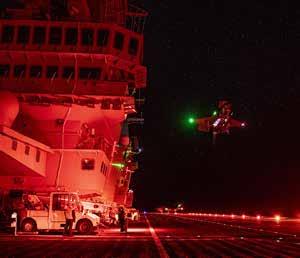
28 minute read
as she prepared for her upcoming deployment. Two of her strike group
from Navy News April 2021
by Navy News
THE Royal Navy’s Fleet Flagship, HMS Queen Elizabeth, makes her way to Glen Mallan in Scotland, as part of final preparations before her first operational deployment.
Sailing in along the Firth of Clyde, the 65,000-tonne aircraft carrier spent two weeks at sea testing and trialling her latest equipment, before berthing at the new Northern Ammunition Jetty for a routine onload of operational stores.
Advertisement
HMS Queen Elizabeth is the first of the Royal Navy’s fleet to visit the new £64 million facility, built by the Defence Infrastructure Organisation (DIO).
It was the first time HMS Queen Elizabeth visited Western Scotland, after she initially became a familiar sight on the River Forth where she was assembled.
Captain Angus Essenhigh, HMS Queen Elizabeth’s Commanding Officer, said: “We are very proud of the close connection our ship has with Scotland, especially with our affiliated city of Edinburgh.
“HMS Queen Elizabeth embodies the best of British engineering and craftsmanship, including Scottish shipbuilding, and it is a privilege to return to her birthplace of Scotland.”
DIO project works undertaken include: the installation of four new navigational aids to ensure safe passage through the confined waterway in Loch Long, two new modular fender spacer units that move with the tide to prevent the aircraft carrier flight deck from coming into contact with the jetty and the installation of dolphin mooring points to ensure the carrier can be securely berthed.
The ship will deploy to the Mediterranean, Indian Ocean and East Asia later this year, leading the UK’s Carrier Strike Group.
Meanwhile, HMS Defender and HMS Kent both left Portsmouth for intensive training ahead of joining landmark deployment. The Type 45 destroyer is earmarked to provide air defence and Kent to ward off submarine threats among other roles and duties in the task group. Commanding Officer of HMS Defender, Commander Vince Owen, said: “It is a great feeling to be able to take HMS Defender back to sea after this period alongside for maintenance.”
Engineering Technician (CIS) Tom Longley said: “Having been alongside since October it’s great to go to sea and get back into the swing of things. I’m really looking forward to deploying later this year.”
Kent’s Commanding Officer, Commander Matt Sykes, said: “The last three months in Portsmouth have been vital to make sure Kent is ready to deploy with the Carrier Strike Group in the spring.
“Achieving this during the ongoing pandemic has not been easy and I am extremely grateful to HM Naval Base Portsmouth, the waterfront support organisations and service providers for all their hard work to get us back to sea on time.”
In addition to routine maintenance, various new equipment has been fitted, including infrastructure to support embarkation of the Royal Navy’s new Martlet missile carried by the ship’s Wildcat helicopter.
Defender worked closely with HMS Queen Elizabeth late last year on the Carrier Strike Group workout in the North Sea in preparation for operations.
Alongside sister ship HMS Diamond, plus Type 23 frigates and warships from NATO allies, Defender formed the ring of steel around the aircraft carrier that is designed to protect the Queen Elizabeth-class carriers from enemy ships, submarines, aircraft and missiles, but are also capable of conducting a range of supporting missions, from maritime security to disaster relief.
The Type 45 then headed for extensive top-to-bottom maintenance ahead of a busy 2021, including capability upgrades being fitted, a fresh coat of paint and routine upkeep on the exterior of the state-of-the-art multifunction radar, which required a massive 80 tonnes of scaffolding to access it.
Personnel from both Defender and Kent took part in the digital Exercise Virtual Warrior alongside sailors from the carrier, plus battle staff, playing out a simulated crisis at HMS Collingwood to test their collective abilities and responses.
Picture: CPO (Phot) Nick Tryon

British pilot paves way for Italian F-35 carrier ops
FLEET Air Arm aviator Barry ‘Baz’ Pilkington became only the second person to land the world’s most advanced naval fighter on the deck of Italian carrier Cavour.
The Brit is flying F-35s on and off the Italian flagship, helping to lay the foundations for our NATO ally to join the elite club of navies operating the stealth fighter from aircraft carriers.
The Cavour, which has been in service with the Marina Militare for more than a decade, is swapping veteran Harrier jets for the Lightning – and the same short take-off/vertical landing variant (the ‘B’ model) as used by the US Marine Corps, Fleet Air Arm and RAF.
The Italian carrier underwent extensive conversion to operate the fifth-generation F-35 jets. Ultimately she’ll be able to host ten of the jets in her hangar and six on the flight deck.
Like HMS Queen Elizabeth before her, the Cavour has sailed to the Eastern Seaboard of the USA for her initial trials with two F-35s from the US Marine Corps squadron, one flown by Major Brad Leeman, the second by Lt Cdr Pilkington.
After completing his F-35 training with the US Marine Corps a couple of years ago, the lieutenant commander remained Stateside, joining the marines’ Air Test and Evaluation Squadron (VX 23) based at ‘Pax’ River air base in Maryland.
There the Brit was assigned to the F-35 Integrated Test Force – the world’s most experienced unit when it comes to operating the jet.
As with Queen Elizabeth’s first visit to the same waters in the autumn of 2018, the debut of the jets aboard ITS Cavour helps write the Italians’ ‘operator’s manual’ for using the state-of-the-art Lightnings: deck handling, refuelling, launch and recovery by day and night, safe movement of the aircraft around the deck.
mersey’s watching
HMS Mersey has tracked the movements of a surfaced Russian submarine as it sailed through waters close to the UK.
The River-class offshore patrol vessel was on watch as the Kilo-class diesel powered attack submarine RFS Rostov Na Donu sailed through wintry seas in the North Sea and English Channel on its journey from the Baltic to the Mediterranean.
Mersey reported on the movements of the Russian Black Sea Fleet submarine, so that NATO Allies could track her progress as she continued her onward journey.
Commanding Officer of HMS Mersey, Lieutenant Commander Will EdwardsBannon, said: “All of us in Mersey are very proud of the part we play, here in our home waters, in fulfilling the Royal Navy’s role of protecting our nation’s interests.
“No patrol is ever the same as the last and we have conducted a particularly varied range of missions recently, culminating with the tracking of this Russian submarine as it passes the UK.”
Mersey was also on duty when the Kiloclass submarine made the reverse journey in October last year, as she returned from operations in the Mediterranean back to the

RUSSIAN KILO-CLASS SUBMARINE PASSES THROUGH WATERS CLOSE TO THE UK TRACKED BY HMS MERSEY
Baltic.
This latest operation comes amid a busy time for the Royal Navy’s patrol ships, with Mersey and her sister ships HMS Tyne and HMS Severn all on maritime security patrols in the seas around the UK.
Royal Navy patrol ships are involved in a range of missions, including fishery protection, which has been their responsibility for many years, but also coordinating with the Joint Maritime Security Centre to share information relating to suspicious or dangerous activity at sea alongside the Maritime and Coastguard Agency and National Crime Agency.
“You never know what’s around the corner when serving in these ships, but you can always rely on Mersey and her fantastic ship’s company, made-up of both regulars and reservists, to get the job done,” added Lt Cdr Edwards-Bannon.
Sub Lieutenant Andrew Davidson, one of Mersey’s Officers of the Watch, said: “I only joined Mersey last month and she is my first ship as a qualified Bridge watch-keeper.
“I’ve been impressed by the range of missions that we have already been involved with over such a short period of time.
“It feels good to have the opportunity to be out here doing something worthwhile for the UK, especially when you know how much good is being done at home by our NHS, key-workers and all those involved with the Covid-19 vaccine roll-out.”
HMS Mersey during an operation tracking a surfaced Russian submarine
Discover your pension potential
You may think the benefi t you’ll receive from your Armed Forces pension is set in stone. Think again. You have numerous ways to determine what you will receive by understanding and exercising the many options available to you. This is what we call your pension potential. And when you join us, our Pension Advisory Team will guide you through these options to help you make better choices.
HELPING YOU MAKE BETTER CHOICES
CHAMPIONING ARMED FORCES PENSIONS SINCE 1946

Join us. Job done.
Independent, not-for-profi t
Independence is vital to our work, calling governments to account whenever we spot injustice or unfairness in the system and this year we celebrate our 75th Anniversary of supporting the Armed Forces Community. We are funded entirely by subscriptions from our membership – now over 60,000 strong. Any surplus helps fund our outreach programmes of free-to-attend Roadshows at bases throughout the country and overseas, and our attendance at CTP Employment Fairs.
Visit: forcespensionsociety.org/join-now/
Annual membership for you and your spouse/partner is just £41. As a Member, you will have exclusive access to our Pension Advisory Team and our informative Webinars – and you’ll receive our bi-annual e-newsletters and magazine, Pennant. You’ll also have access to our wide range of membership benefi ts from discounts on new cars and white goods, to insurances, low-cost money transfers and a good deal more.
IT PAYS TO UNDERSTAND YOUR PENSION

Wave goodbye to lengthy surveys

THIS is Plymouth Harbour, Sound, and environs as you have never seen them before.
This is not a satellite image. It was produced by a standard Royal Navy navigational radar and specialist software, tested for the first time by HMS Magpie.
In fact this composite image of the Plymouth/Rame Head coastline is a ‘by-product’; the real trick of what scientists call radar bathymetry is to map the seabed close to shore in hours – not days or weeks – by measuring wave height (a radar image of waves around the breakwater is pictured inset).
Using that data and information about currents, the software can produce a detailed profile of the seabed in a matter of hours – without the ship or boat having to physically sail over the area being surveyed.
All the system needs is wind and a swell to generate waves – plus computing power.
It is not as detailed as the scans Magpie or other Royal Navy survey vessels can produce with their hi-tech sonar suites – and it only works close to shore.
But the method – developed by scientists from the National Oceanography Centre in Liverpool and MOD experts from Defence Science and Technology Laboratory – could be vital in times of peace or war when time is critical.
“By analysing the sea clutter images of waves visible on standard marine radars a bathymetric profile (that’s the depth) and surface current assessment is created,” explained the lead project scientist at the National Oceanography Centre, Paul Bell.
“This technique could allow the remote charting of both shallow water and currents from a standoff distance of several nautical miles and could be employed by all Royal Navy Ships using the navigation radars that are already fitted with.” Given her size, Magpie doesn’t carry the standard navigational radar used by the rest of the Fleet, so one was temporarily installed on a roof rack. It would take the ship perhaps a fortnight to map the ocean floor on the approaches to Plymouth naval base and the Sound with her sonar. It took the software just hours to do the same. Time could be the difference between life and death in the aftermath of a natural disaster with a possible shifting seabed preventing the usual access to harbours or beaches or an amphibious landing on or evacuation from poorly/uncharted shores. At present the software is still in development, but the goal is to integrate it with the Royal Navy’s existing navigational radar and systems – no new equipment would be required in most cases, just upgraded software – to provide accurate, real-time seabed maps.
“The Royal Navy is continually looking to employ new up-to-date technologies,” said Lieutenant Commander Mark White, HMS Magpie’s Commanding Officer.
“The beauty of this concept is that it uses the existing radars already fitted to our ships.
“It was excellent to work alongside the National Oceanography Centre to trial and develop these new and exciting techniques that could have a wide range of use in the Royal Navy.”
More regular duties are in store for Magpie shortly. Having just emerged from her annual winter overhaul, the ship is due to head up the East Coast to conduct traditional survey work of ports and harbours.
l One of the recovered cannon is lowered into a tank for preservation

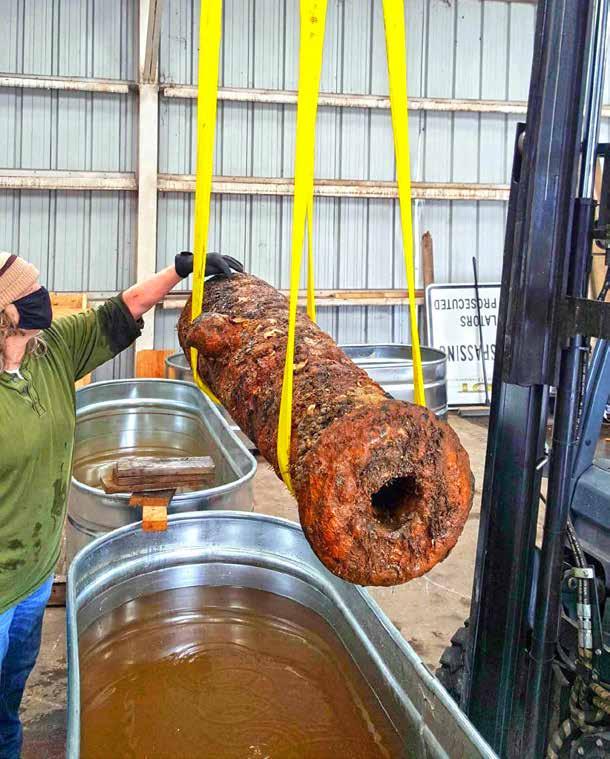
Picture: US Army Corps of Pioneers
‘Rose’ found in mud
AMERICAN soldiers may have accidentally found the remains of a British warship which was the scourge of their countrymen during the War of Independence.
Cannon, an anchor and other objects – thought to belong to HMS Rose – were dredged from the bed of the Savannah River, nearly 250 years after the ship was scuttled at the height of the conflict.
The artefacts have yet to be positively identified, but given their location and the fact they pre-date the American Civil War by a century, Royal Navy historians believe they are likely to date to the siege of Savannah in 1779.
HMS Rose was sunk in the river to deny the French Navy access to the Georgian capital – held by British forces – in support of American troops besieging it.
The ship – a sixth rate armed with 20 cannon – had been active in the Americas throughout the 1770s. Her success in intercepting smugglers to Rhode Island prompted the Americans to commission their first armed ship in response, the sloop Providence, and form the Continental Navy – forerunner of today’s US Navy.
The British vessel also frequently conducted forays up the Hudson River, which helped to drive George Washington out of New York when war broke out and continued to patrol the Eastern Seaboard until the decision to use her as a blockship off Savannah.
The British abandoned the city in 1782 and the wreck was largely cleared away to allow free navigation of the river to resume.
And there it remained until the US Army Corps of Engineers was conducting dredging operations in the river when it found the objects, put a halt to further dredging and recovered the historic items.
Archaeologists and naval historians on both sides of the Atlantic are trying to identify the wreck definitively.
“It is exciting when artefacts from naval history are found,” said Commander Jim Morley, the UK’s assistant naval attaché in Washington.
“The discovery of an anchor, cannons, and ship timbers gives us a great opportunity to work with our US colleagues and allies to help identify them.
“The possibility that they may, in fact, be from HMS Rose, a Royal Navy vessel that was part of our fleet operations during the American Revolutionary war is fascinating.”
Contemporary records show that Rose was one of two ships sunk on the bar at the mouth of the Savannah River in September 1779 and prevented the French fleet from getting close to the namesake city, thus providing support American soldiers attacking it.
All the crew survived the sinking and subsequently joined the defence of Savannah.
They played a key role in lifting the siege, though Rose’s Captain Philip Browne was killed.
A near-replica of the ship was built in 1970 in Canada and subsequently was turned into HMS Surprise ‘captained’ by Oscar winner Russell Crowe in Master and Commander. She’s now a museum ship in San Diego.

By Appointment to Her Majesty The Queen Medallists Worcestershire Medal Service Ltd Bromsgrove
Worcestershire Medal Service Ltd
Specialists in Orders, Decorations and Medals 56 Broad Street, Sidemoor, Bromsgrove, B61 8LL
Medals mounted for wear and display Miniature and full size replacement medals supplied, all made in the UK to the highest standard. See our web site where you can order securely on-line www.worcmedals.com or call 01527 835375 and our team will be pleased to help you.
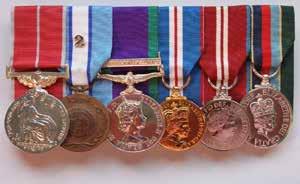
Last but not least
A FIRST venture into the Solent marked the debut of HMS Spey under the White Ensign, as she began the journey to joining her sisters as fully-fledged members of the Overseas Patrol Squadron.
Her Ready for Sea Date inspection was passed, allowing Commanding Officer Ben Evans to take the 90-metre patrol vessel out for the start of the next phase of tests, trials and training.
He said: “The ship’s company and
I have been enjoying a succession of firsts with HMS Spey, and there will be more to come as we build towards the excitement of our first operational deployment.” That deployment will be announced at the appropriate time, but Fleet Operational Sea Training will need to be successfully negotiated later this year after the ship’s company have grown accustomed to their new home. The fifth and final of the second-generation of River-class ships built for the Royal Navy, Spey arrived in Portsmouth in October under the Blue Ensign as a ship in public service but was yet to enter the Royal Navy. That changed in early January when the White Ensign replaced Blue.
After receiving a ship’s company of around 60 men and women, who will rotate off and on-watch to maintain a crew of about 45 on board at any time, the road to operational status can begin.
Designed for work in UK waters or overseas, she has a mess deck for 50 embarked troops and a helipad capable of receiving the Fleet Air Arm’s Wildcat or Merlin.
When she becomes operationally active she will be the eighth River class vessel in Royal Navy service with HMS Forth, Medway currently on operations in the South and North Atlantic and Mediterranean respectively. The other patrol vessels are active in UK waters.
Picture: LPhot Unaisi Luke
United Kingdom Special Forces
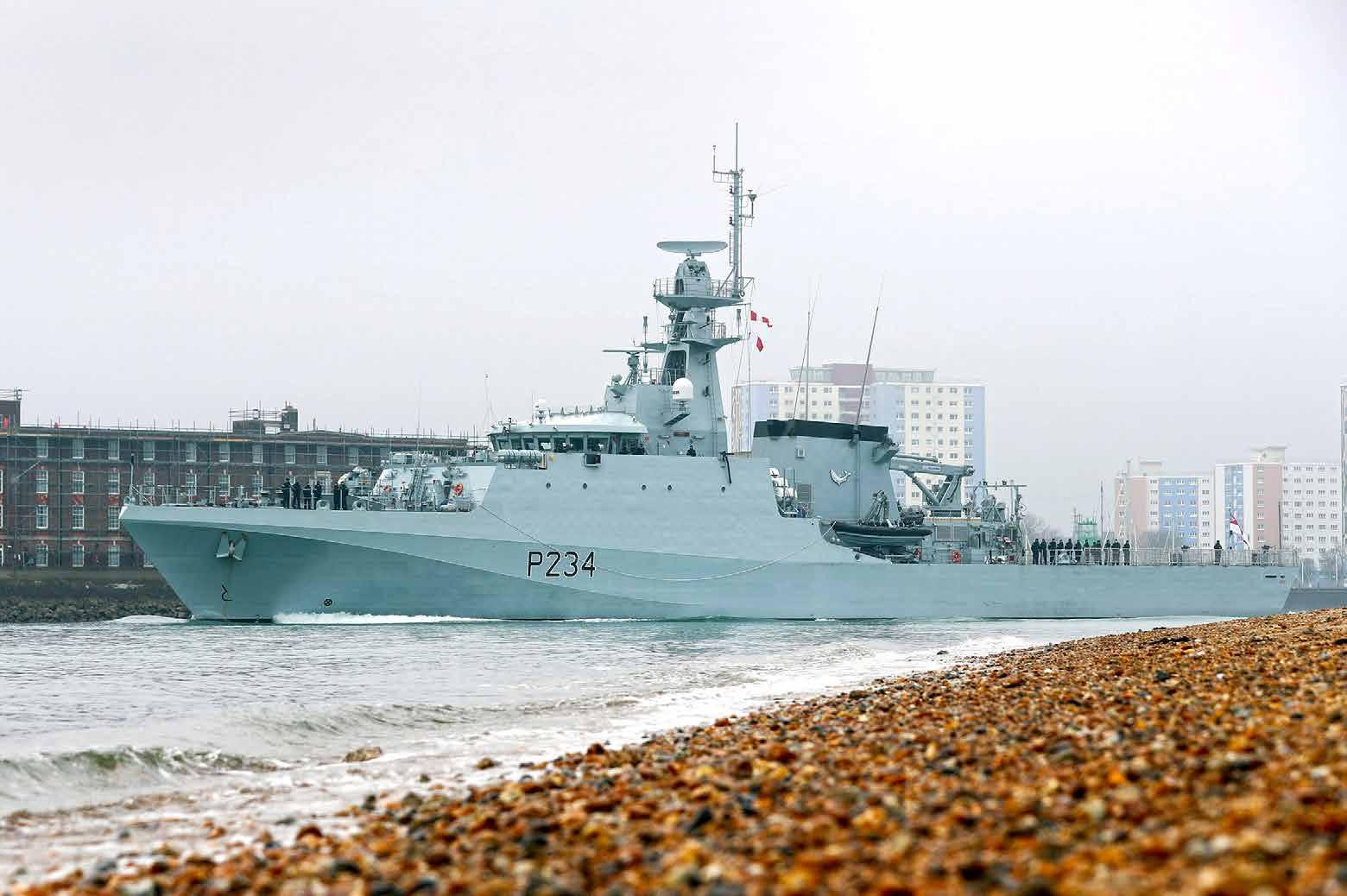
BY STRENGTH AND GUILE

Search UKSF on MODnet
SFTC-UKSF-Recruiting@mod.gov.uk

Blyth’s Baltic blast

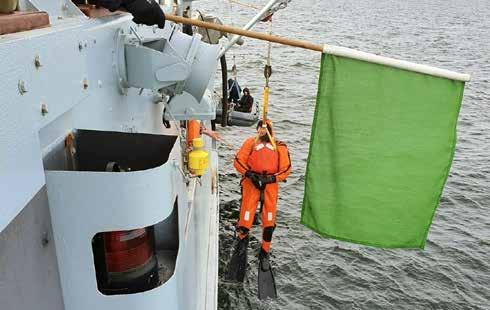


THE Baltic has become a major focal point of Royal Navy effort in the opening months of 2021, behind only the Gulf and home waters with the concentration/ deployment of British warships.
While Lancaster, Westminster and Tiderace were JEFfing in the eastern Baltic, HMS Blyth has been NATOing off the western shores in Standing Mine Countermeasures Group 1 – with the same ultimate goal of safety and security... though by different means. The UK-led JEF is the new kid on the Baltic block, established as recently as 2018. The NATO mine group traces its history back nearly 50 years as, first, Standing Naval Force Channel, then Mine
Countermeasures Force North Western Europe in 2001, before assuming its present form in 2005. For Blyth and her partners Public Enemy No.1 is the mine in all its forms. And there are still plenty of them out there.
The Baltic is among the most heavily-mined waterways thanks to two world wars, compounded by bombers dumping their payloads, training or mis-fired torpedoes, depth charges which failed to detonate and so on. Passage of time with layers of silt accumulating on the old explosives, water temperatures of 3°C (it’s a balmy 6°C in Blyth’s home base of Faslane), strong currents and poor visibility make neutralising old (or present-day, for that matter) ordnance something of a challenge. But plunge into the waters of the
Kattegat (separating Jutland from
Scandinavia) Blyth’s dive team did as the group conducted a concerted period of historic ordnance disposal off the Danish coast. The Danes are not formally part of the NATO group in its current iteration (it’s led by the Dutch, commanding from a German support ship, and directing the actions of minehunters Godetia from Belgium and Ugandi from Estonia, plus Blyth), giving them free rein in their main exercise area. The MULTEX range off the Sjaelland Odde peninsula – about 50 miles northwest of the Danish capital – is run by the Danish Navy, who operate aerial drones and automated boats as realistic moving targets, as well as more traditional floating targets for ships to aim at. To stop an attacker in his tracks, Blyth alone can call upon a 30mm main gun, .50 calibre heavy machine-guns, Minigun Gatling guns, standard machine-guns and finally small arms in the hands of the ship’s Standing Sea Response Force. Although Blyth is highly manoeuvrable, like all minehunters she’s not fast; the NATO group relies on safety in numbers, good communications, collective firepower and, not least, good marksmanship.
And while the gunners were throwing up walls of lead above decks, below the responses of firefighting and damage-control teams and medics were also being tested.
As a result, the time spent on the Danish range was hailed as “great training for all units”. “The opportunity to train force protection against a realistic and moving threat within a formation is rare. Therefore the MULTEX range was excellent training for the group,” said the NATO force commander, Commander Jan Wijchers.
With Blyth the newest arrival to his force, he spent a day aboard the ship getting to know the ship, the kit, the 40-plus sailors aboard and some of their foibles.
Like uckers. Blyth’s CO ran through the wardroom/mess deck favourite, baffling his guest with talk of blobs, mixi-blobs, eight piecers and eight pieces in harbour.
The Dutchman was at least familiar with the outline and abilities of Blyth, for Estonia’s representative in the force, ENS Ugandi, is the British vessel’s sister.
Ugandi is one of three Sandown-class ships snapped up by the small Baltic state in the mid-00s when the Royal Navy decided they were no longer required. Mine warfare experts Able Seamen Ewan Wigham and Jason Kelbie spent an afternoon aboard the Estonian ship to see how the Baltic navy operates a Sandown-class vessel while she conducted manoeuvres with Blyth. “It is great to be in a NATO Group which includes another Sandown-class ship and we are thoroughly enjoying working closely with our Estonian allies,” said Blyth’s navigator Lieutenant Conor Smith.
“ENS Ugandi is clearly in capable hands, and two Sandowns working together pack a serious mine-hunting punch.”
With the relatively limited endurance of minehunters (fuel/food), and the force’s mission of flying the flag for NATO (when not hunting mines), it means spells at sea are fairly short and port visits frequent.
Kristiansand in southern Norway was cold, snowy, but a welcome haven after a very lumpy crossing of the North Sea, while Kiel in Germany has become a ‘second home’ for the group... although to date Covid restrictions have prevented the sailors exploring their overseas destinations.
They have, however, been permitted a leg stretch ashore and a spot of sport while their ships topped up on food and fuel.






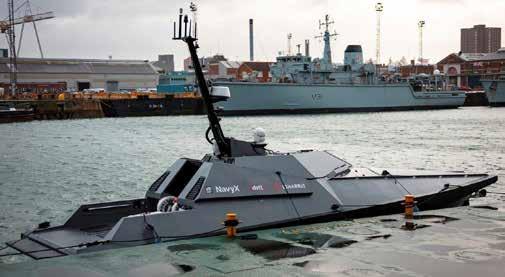
Apprentices for autonomy
THE Royal Navy is joining a partnership to provide apprenticeships in autonomous and crewless vessel operations.
Maritime training specialist SeaBot XR is collaborating with the navy and other industry partners to identify the skills needed for the maritime autonomous surface ship (MASS) sector.
The scheme will create a working group to develop the use of apprentices for remote and autonomous operations both above and below the surface.
Initially, the group will identify the basic skills and knowledge an individual will need to safely navigate, control and manage small to medium-sized vessels, and provide them with suitable certification.
It will also analyse emerging requirements and define various occupational and training standards.
As the industry grows, the group will then use this training to build upon basic skills, with more advanced knowledge routes and specialisms that will be required for the operation of maritime autonomous surface ships.
Autonomy and crewless technology has been a focus of the Royal Navy’s for the past two years with several exercises putting different boats (pictured) and drones through their paces. This includes on operations with the Royal Marines and HMS Albion.
Commodore Andy Cree Royal Navy
said: “The Royal Navy through its lead of the Solent Maritime Enterprise Zone, has a sharp focus on identifying and addressing the future skills gaps associated with new and emergent maritime technologies. “We are therefore delighted to be part of this Apprenticeship Trailblazer Group developing employer-led apprenticeship standards in autonomous and remote vessel operations which will pave the way for a skilled maritime workforce of the future.” The Apprenticeship Trailblazer Group is chaired by SeaBot XR. As well as the Royal Navy, the list of employers includes geo-data specialist Fugro, the United Kingdom National Oceanography Centre and marine robotics company Ocean Infinity. The insurer Shipowners P&I Club and the UK Maritime and Coastguard Agency (MCA) will also participate in the group. It is being supported through the development process by the regulator for apprenticeship quality, the Institute for Apprenticeships and Technical Education. Gordon Meadow, chief executive of SeaBot XR, said: “A new apprenticeship in autonomous and remote vessel operations will provide new talent and even greater, multidisciplined, highlytrained workforce, with the know-how to safely monitor, control and deal with situations remotely.”
Fellowship returns

FORTY-SIX personnel from the Royal Navy and Royal Air Force have become the second cohort to take part in the Percy Hobart Fellowship.
Launched last year, the course encourages serving men and women to think about new technologies and how they could enhance the military.
For this year, people from the navy are being joined by the RAF. It will give them a unique learning environment to understand the powers and practicalities of new technology to help champion innovation within the Defence sector.
The fellowship is a one-of-akind 12-week course, focused on digital transformation, business principles and agile thinking.
Through secondments into civilian-led start-ups, those taking part will have the opportunity to learn first-hand what it’s like to conceive new ideas, develop products and translate these principles into tangible benefits that drive innovation in the Royal Navy and Royal Air Force.
Following the success of the inaugural cohort last year, the Ministry of Defence has awarded PUBLIC the contract to deliver the second fellowship.
First Sea Lord, Admiral Tony Radakin said: “This fellowship empowers our people to think differently about technology and innovation.
“Last year’s fellowship was a great success, and I’m delighted more of our talented people have the opportunity to bring the skills they will learn from industry back to defence.”
Fellows will return to the navy and air Force later this year with an experienced understanding of the fundamentals in business and technology.
Wren calls time after 43 years in service
BARBARA McGregor only joined the Royal Navy for four years to enjoy a bit of sport and adventure.
She has just left the Service as possibly the longest-serving female member of Britain’s Armed Forces (World record experts Guinness are checking the statistics): 43-and-a-half years, retiring as a Warrant Officer 1st Class.
Barbara joined the Women’s Royal Naval Service (better known as the Wrens) on July 26 1977 – when Donna Summer’s I Feel Love was filling dance floors, Roger Moore’s James Bond was putting backsides on cinema seats in The Spy Who Loved Me and the UK was celebrating the Queen’s Silver Jubilee.
She transformed from civilian to Wren at the (now-closed) HMS Dauntless, near Reading before completing her specialist training as a communicator at HMS Mercury (also now closed) near Petersfield where she and her fellow trainees were inspected by Lord Mountbatten on the day before Barbara’s 18th birthday.
“He wasn’t what I expected - much less formal and quite a slight figure. He got everyone to gather around him where he told us stories of his naval experiences,” Barbara recalled.
As a communicator it was Barbara’s job to pass that news on – and other important signals, instructions and messages – to ships, submarines and units scattered around the globe: a painstaking and laborious job largely replaced today by email which can be dispatched and read in a matter of seconds.
It was while serving in the communications centre in Gibraltar that Barbara decided on a change of career. “We worked inside the Rock on 12-hour watches and rarely saw daylight. I thought: this isn’t what I want to do and decided to become a regulator [the Royal Navy’s police].”
Despite 43-and-a-half years in the Navy, almost none of it has been spent at sea; Barbara joined 16 years before women went to sea and chose to remain as a non-seagoer – although that did include three overseas postings, including time in Diego Garcia, the tiny British territory in the Indian Ocean, as well as Gibraltar.
Instead, much of Barbara’s later career has involved passing on her knowledge and experience to new generations of sailors while serving at HMS Raleigh in Torpoint, which turns civilians into Royal Navy personnel.
And for the past 21 years she has been a member of the Royal Naval Careers Service – from running the office in Cardiff, through to being in charge of the Midlands, Wales and South West regions to finally acting as the First Warrant Officer of the Careers Service, which took her to all 49 careers offices from Inverness to Redruth, advising the Navy’s senior officers on recruitment.
It’s a role which she found hugely rewarding. “The job was to raise the profile of recruiting and we’ve done that. We’ve also changed the way we recruit. Whichever careers office someone attends they will be treated the same way – the process is identical.
“I feel so fortunate to have achieved what I have achieved – especially for someone who only joined up for four years. I’ve been very lucky with my postings and had some fantastic experiences.” Married to Stuart – also a naval regulator, though long retired – among her proudest moments for the 61-year-old from Bridgend in South Wales was helping to organise the NATO summit hosted in Cardiff attended by the world’s political and military leaders. A trustee of the Association of Wrens, Barbara led its contingent at the annual Remembrance parade in Whitehall and was due to represent them at the Cenotaph again last November – marking the association’s 100th anniversary – only for the pandemic to scupper plans. Her work with the Association con-tinues in retirement, how-ever. With fellow female sailors past and present around the world in lockdown she’s organised the ‘Wrens Out Walking’ project to keep more than 260 women fit and healthy during lockdown. Collectively, they are running, cycling, walking or rowing the distance of the longest continuous walk on the planet: from Magadan in far eastern Russia to Cape Town in South Africa: 14,211 miles. “It would take someone on their own walking eight hours a day for 365 days to cover. We have just ‘passed’ Khartoum already in two months. We’re going to have to find a new challenge for the rest of the year.” Barbara added.
Your WelComE account card...
A WelComE account card is assigned to you for your entire military career and can be used to access telephone and Internet services whilst deployed.
You should receive it after basic training. If you haven’t been given it, speak to your admin officer. For more information visit: www.mywelcome.co.uk
Lost your account card? No worries! Speak to your admin officer who will be able to provide you with your WelComE account number and a password to reset your PIN.


